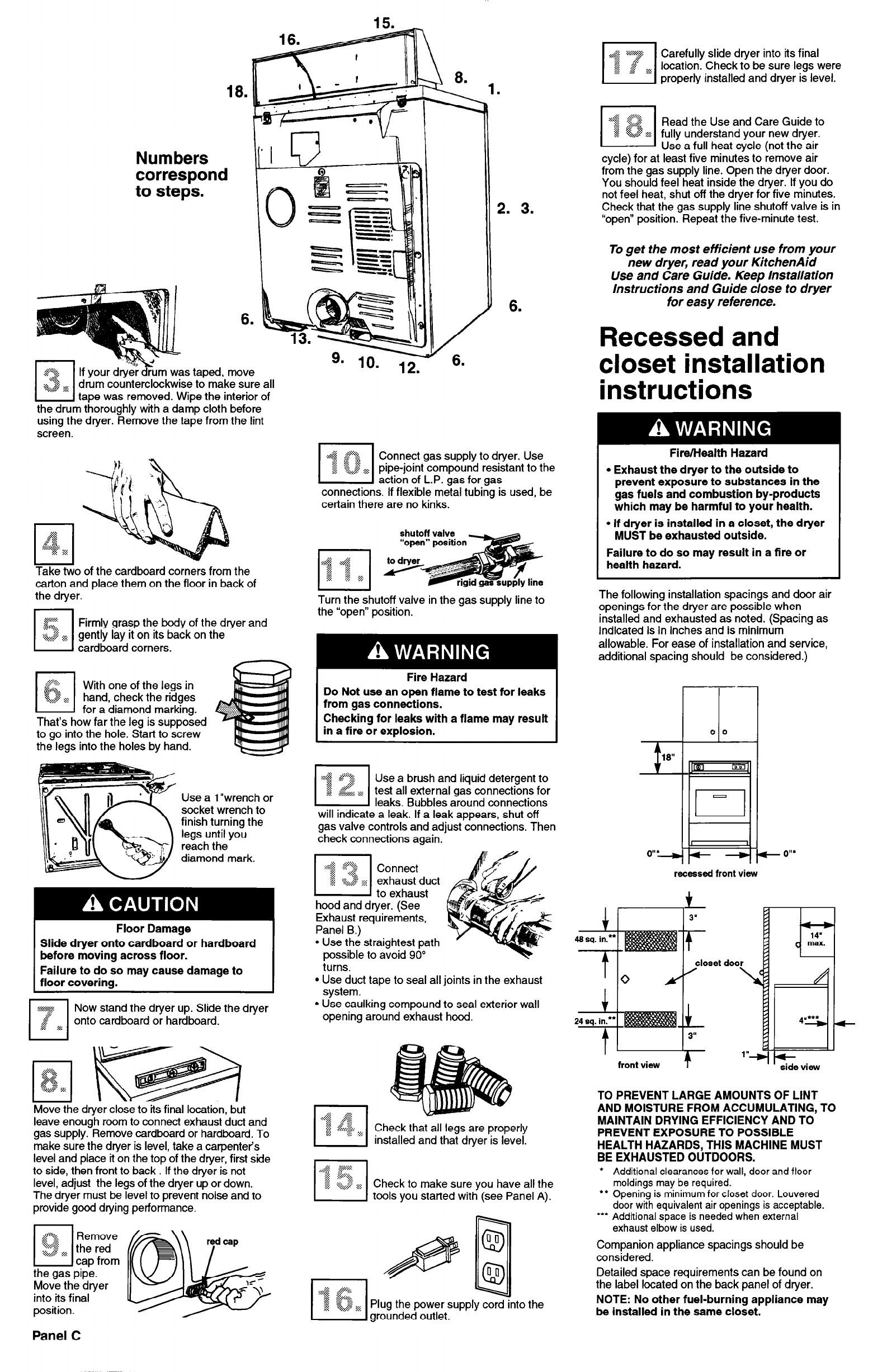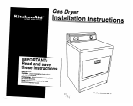
Carefully slide dryer into its final
location. Check to be sure legs were
properly installed and dryer is level.
18.
*q; ::y$:.
.k< ..: _ $5
I
:2 ..:.- ‘<.
Read the Use and Care Guide to
3 %! z fully understand your new dryer.
Use a full heat cycle (not the air
cycle) for at least five minutes to remove air
from the gas supply line. Open the dryer door.
You should feel heat inside the dryer. If you do
not feel
heat, shut off the dryer for five minutes.
Check that the gas supply line shutoff valve is in
“open” position. Repeat the five-minute test.
Numbers
correspond
to steps.
2. 3.
6.
To get the most efficient use from your
new dryer, read your KitchenAid
Use and Care Guide. Keep Installation
Instructions and Guide close to dryer
for easy reference.
6.
Recessed and
closet installation
instructions
&&,
%Y y;
*%
u
If your dryer dTum
was taped, move
:+, $5.
**&, TG drum counterclockwise to make sure all
tape was removed. Wipe the interior of
the drum thoroughly with a damp cloth before
using the dryer. Remove the tape from the lint
screen.
Fire/Health Hazard
l
Exhaust the dryer to the outside to
prevent exposure to substances in the
gas fuels and combustion by-products
which may be harmful to your health.
l
If dryer is installed in a closet, the dryer
MUST be exhausted outside.
Failure to do so may result in a fire or
health hazard.
Connect gas supply to dryer. Use
pipe-joint compound resistant to the
action of L.P.
gas
for gas
connections. If flexible metal tubing is used, be
certain there are no kinks.
Taketwo of the cardboard corners from the
carton and place them on the floor in back of
the dryer.
The following installation spacings and door air
openings for the dryer are possible when
installed and exhausted as noted. (Spacing as
indicated is in inches and is minimum
allowable. For ease of installation and service,
additional spacing should be considered.)
Turn the shutoff valve in the gas supply line to
the “open” position.
Firmly grasp the body of tl
gently lay it on its back on
cardboard corners.
78 dryer and
the
With one of the legs in
hand, check the ridges
for a diamond marking.
That’s how far the leg is supposed
to go into the hole. Start to screw
the legs into the holes by hand.
Fire Hazard
Do Not use an open flame to test for leaks
from gas connections.
Checking for leaks with a flame may result
in a fire or explosion.
Use a brush and liquid detergent to
test all external gas connections for
leaks. Bubbles around connections
will indicate a leak. If a leak appears, shut off
gas valve controls and adjust connections. Then
check connections again.
Use a 1 “wrench or
socket wrench to
finish turning the
legs until you
reach the
diamond mark.
hood and dryer. (See
Exhaust requirements,
Panel B.)
l Use the straightest path
possible to avoid 90”
turns.
l Use duct tape to seal all joints in the exhaust
system.
l Use caulking compound to seal exterior wall
opening around exhaust hood.
recessed front view
14"
max.
T
+I
Floor Damage
Slide dryer onto cardboard or hardboard
before moving across floor.
Failure to do so may cause damage to
floor covering.
doo
zq$
$9
u
Now stand the dryer up. Slide the dryer
.g
onto cardboard or hardboard.
i’
A>
front view f
Move the dryer close to its final location, but
leave enough room to connect exhaust duct and
gas supply. Remove cardboard or hardboard. To
make sure the dryer is level, take a carpenter’s
level and place it on the top of the dryer, first side
to side, then front to back If the dryer is not
level, adjust the legs of the dryer up or down.
The dryer
must
be level to prevent noise and to
provide good drying performance.
’ ’ side view
TO PREVENT LARGE AMOUNTS OF LINT
AND MOISTURE FROM ACCUMULATING, TO
MAINTAIN DRYING EFFICIENCY AND TO
PREVENT EXPOSURE TO POSSIBLE
HEALTH HAZARDS, THIS MACHINE MUST
BE EXHAUSTED OUTDOORS.
l
Additional clearances for wall, door and floor
moldings may be required.
‘+ Opening is minimum for closet door. Louvered
door with equivalent air openings is acceptable.
l
” Additional space is needed when external
exhaust elbow is used.
Companion appliance spacings should be
considered.
Detailed space requirements can be found on
the label located on the back panel of dryer.
NOTE: No other fuel-burning appliance may
be installed in the same closet.
Check that all legs are properly
installed and that dryer is level.
Check to make sure you have all the
tools you started with (see Panel A).
.,z+:
*. ,:::<
u
Remove
y:::<,y$
:~cc,:v <.) the red
.....
...
cap from
the gas pipe.
Move the dryer
into its final
position.
the
Panel C







